
Hopak is a Ukrainian folk dance originating as a male dance among the Zaporozhian Cossacks, but later danced by couples, male soloists, and mixed groups of dancers. It is performed most often as a solitary concert dance by amateur and professional Ukrainian dance ensembles, as well as other performers of folk dances. It has also been incorporated into larger artistic opuses such as operas, ballets and theatre.
Ukrainian literature is literature written in the Ukrainian language.

The National Academy of Sciences of Ukraine is a self-governing state-funded organization in Ukraine that is the main center of development of science and technology by coordinating a system of research institutes in the country. It is the main research oriented organization along with the five other academies in Ukraine specialized in various scientific disciplines. NAS Ukraine consists of numerous departments, sections, research institutes, scientific centers and various other supporting scientific organizations.
Trepak, also referred to as the Russian dance, is one of the character dances from Pyotr Ilyich Tchaikovsky's famous 1892 ballet The Nutcracker. It is based on the traditional Russian and Ukrainian folk dance also called the trepak.

Ukrainian dance mostly refers to the traditional folk dances of the Ukrainians as an ethnic group, but may also refer to dances originating from the multiple other ethnic groups within Ukraine.
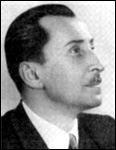
Pavlo Pavlovych Virsky, PAU, was a Soviet and Ukrainian dancer, ballet master, choreographer, and founder of the Pavlo Virsky Ukrainian National Folk Dance Ensemble, whose work in Ukrainian dance was groundbreaking and influenced generations of dancers.

Vasyl Kyrylovych Avramenko was a Ukrainian actor, dancer, choreographer, balletmaster, director, and film producer, credited with spreading Ukrainian folk dance across the world. Colourful, energetic, imaginative, and, quite often exasperating, he was an impresario greatly reminiscent of The Music Man. For his unparalleled missionary zeal and his love of Ukrainian culture, he is considered by many to be the "Father of Ukrainian Dance".
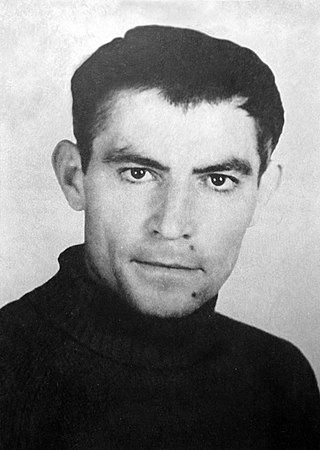
Vasyl Semenovych Stus was a Ukrainian poet, translator, literary critic, journalist, and an active member of the Ukrainian dissident movement. For his political convictions, his works were banned by the Soviet regime and he spent 13 years in detention until his death in Perm-36—then a Soviet forced labor camp for political prisoners, subsequently The Museum of the History of Political Repression—after having declared a hunger strike on September 4, 1985. On November 26, 2005, the Ukrainian president Viktor Yushchenko posthumously awarded him the highest national title: Hero of Ukraine. Stus is widely regarded as one of Ukraine's foremost poets.
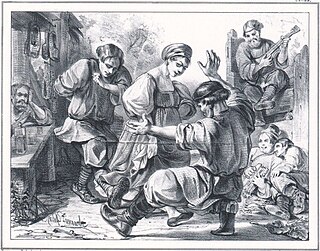
Tropak or trepak is a traditional Russian and Ukrainian folk dance.
Vasyl Andriiovych Symonenko was a Ukrainian poet, journalist, activist of dissident movement. He is considered one of the most important figures in Ukrainian literature of the early 1960s. In the opinion of the Museum of the Dissident Movement in Kyiv, the works and early death of Vasyl Symonenko had an enormous impact on the rise of the national democratic movement in Ukraine.
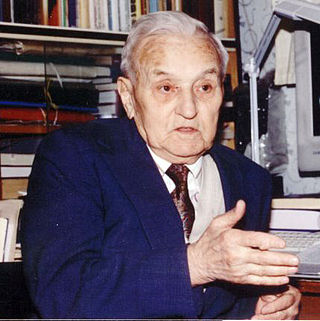
Vasyl Stepanovych Kuk was a Ukrainian nationalist activist and militant who was the last leader of the Ukrainian Insurgent Army, following the death of Roman Shukhevych. In 1954, he was captured by Soviet KGB troops and spent six years in prison without a court sentence.
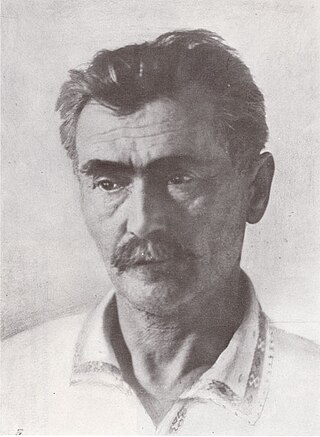
Vasyl Hryhorovych Krychevsky was a Ukrainian painter, architect, art scholar, graphic artist, film art consultant, pedagogue and master of applied art and decorative art. He is the designer of the 1918 Ukrainian coat of arms, state seals, banknotes. He was the brother of Ukrainian painter Fedir Krychevsky.

Shevchenko National Prize is the highest state prize of Ukraine for works of culture and arts awarded since 1961. It is named after the inspirer of Ukrainian national revival Taras Shevchenko. It is one of the five state prizes of Ukraine that are awarded for achievements in various fields.

Lviv National Academy of Arts is a higher education establishment in Lviv, Ukraine.
Bohdan Stepanovich Tsap was a Ukrainian professional football coach and player.
Molod Ukrayiny is a Ukrainian newspaper published daily in Kyiv. It is a Ukrainian language newspaper and the Ukrainian analogue of Komsomolskaya Pravda. Until 1934 it was located in Kharkiv. Since the fall of the Soviet Union the newspapers are privately owned.

Hanna Shostak was a folk painter of Ukraine. She was a member of the USSR Union of Artists and Master of Folk Art of the UkSSR.

The Honorary Diploma of the Verkhovna Rada of Ukraine is an award of the Verkhovna Rada (parliament) of Ukraine for significant contribution to any sphere of life, outstanding socio-political activities, services to the Ukrainian people in promoting and strengthening Ukraine as a democratic, social, legal state, implementing measures to ensure rights and freedoms of citizens, development of democracy, parliamentarism and civil harmony in society, and active participation in legislative activities.













